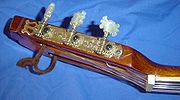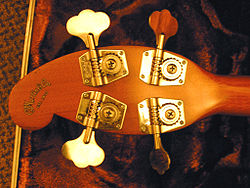
Machine head
Encyclopedia

Headstock
Headstock or peghead is a part of guitar or similar stringed instrument. The main function of a headstock is holding the instrument's strings. Strings go from the bridge past the nut and are usually fixed on machine heads on headstock...
. A headstock has several machine heads, one per string. Non-geared tuning devices as used on violins, violas, cellos, lutes and (formerly) Flamenco guitars and ukuleles are known as tuning peg
Tuning peg
A tuning peg is used to hold a string in the pegbox of a stringed instrument. It may be made of ebony, rosewood, boxwood or other material. Some tuning pegs are ornamented with shell, metal, or plastic inlays, beads or rings....
s.
Construction and action
Traditionally, a single machine head consists of a cylinder or capstan, mounted at the center of a pinionPinion
A pinion is a round gear used in several applications:*usually the smallest gear in a gear drive train, although in the case of John Blenkinsop's Salamanca, the pinion was rather large...
gear, a knob or "button" and a worm gear that links them. The capstan has a hole through the far end from the gear, and the string is made to go through that hole, and is wrapped around the capstan. To complete the string installation, the string is tightened by turning the capstan using the tuning knob. The worm gear ensures that the capstan cannot turn without a movement on the knob; it also allows precise tuning.
Banjo
Banjo
In the 1830s Sweeney became the first white man to play the banjo on stage. His version of the instrument replaced the gourd with a drum-like sound box and included four full-length strings alongside a short fifth-string. There is no proof, however, that Sweeney invented either innovation. This new...
s usually employ a different mechanism using planetary gears - in this case the knob and the capstan both rotate on the same axis. A few guitars (e.g. the original Gibson Firebird
Gibson Firebird
The Gibson Firebird is a solid-body electric guitar manufactured by Gibson from 1963 to the present.-History:The Gibson Guitar Corporation released several new styles during the 1950s to compete with Fender's instruments, such as the Telecaster and Stratocaster. After success with the Les Paul in...
, early Gibson basses and Mario Maccaferri's plastic instruments) have used this design.
The guitarist adjusts the tension of the various strings using the knobs so that they are correctly tuned
Guitar tunings
Guitar tunings almost always refers to the pitch of the open string, though some tunings may only realistically be attained by the use of a capo on an unmodified instrument....
: a higher tension yields a sharper pitch, a lower tension a flatter pitch. Typical tensions for steel-string acoustic guitars with "light" tension strings are 10.5 kgf
KGF
KGF may refer to:*Keratinocyte Growth Factor*King George's Fields A UK set of 471 memorial playing fields and recreation grounds*Kolar Gold Fields*The IATA code for Sary-Arka Airport, Karaganda, Kazakhstan...
(23.3 lbf, 103 N) to 13.8 kgf (30.2 lbf, 135 N).
Varieties
Normally, worm gears provide a gear ratioGear ratio
The gear ratio of a gear train is the ratio of the angular velocity of the input gear to the angular velocity of the output gear, also known as the speed ratio of the gear train. The gear ratio can be computed directly from the numbers of teeth of the various gears that engage to form the gear...
of 14:1, though versions with 18:1 gear ratio also exist. They provide better accuracy in fine tuning, though are somewhat slower for initial string winding.

- on classical guitarClassical guitarThe classical guitar is a 6-stringed plucked string instrument from the family of instruments called chordophones...
s (with nylon strings), the worm gears are generally exposed; the strings are wound on the pins inside grooves in the head; - on steel-string guitars, including "folk" acoustic guitars and electric guitarElectric guitarAn electric guitar is a guitar that uses the principle of direct electromagnetic induction to convert vibrations of its metal strings into electric audio signals. The signal generated by an electric guitar is too weak to drive a loudspeaker, so it is amplified before sending it to a loudspeaker...
s, the worm gears are generally placed in individual sealed enclosures with permanent lubricationLubricationLubrication is the process, or technique employed to reduce wear of one or both surfaces in close proximity, and moving relative to each another, by interposing a substance called lubricant between the surfaces to carry or to help carry the load between the opposing surfaces. The interposed...
, although budget models may have exposed gears fixed on plates housing a row of gears; several machine head placements are possible, depending on the shape of the headstockHeadstockHeadstock or peghead is a part of guitar or similar stringed instrument. The main function of a headstock is holding the instrument's strings. Strings go from the bridge past the nut and are usually fixed on machine heads on headstock...
:- rectangular head, 2 rows of 3 pins (or 6 pins for 12-string guitars): found on most "Folk" and "Jazz" guitars and on Gibson Les PaulGibson Les PaulThe Gibson Les Paul was the result of a design collaboration between Gibson Guitar Corporation and the late jazz guitarist and electronics inventor Les Paul. In 1950, with the introduction of the Fender Telecaster to the musical market, electric guitars became a public craze. In reaction, Gibson...
guitars; - a single diagonal row of 6 pins: found on Fender TelecasterFender TelecasterThe Fender Telecaster, colloquially known as the Tele , is typically a dual-pickup, solid-body electric guitar made by Fender.Its simple yet effective design and revolutionary sound broke ground and set trends in electric guitar manufacturing and popular music...
and StratocasterFender StratocasterThe Fender Stratocaster, often referred to as "Strat", is a model of electric guitar designed by Leo Fender, George Fullerton, and Freddie Tavares in 1954, and manufactured continuously by the Fender Musical Instruments Corporation to the present. It is a double-cutaway guitar, with an extended top...
guitars; - one diagonal row of four pins and one diagonal row of two pins: found on Music ManMusic Man (company)Music Man is an American guitar, and bass guitar manufacturer. It is a division of the Ernie Ball corporation.-Early years:The Music Man story began in 1971 when Forrest White and Tom Walker talked with Leo Fender about starting a company they would call Tri-Sonic, Inc...
guitars;
- rectangular head, 2 rows of 3 pins (or 6 pins for 12-string guitars): found on most "Folk" and "Jazz" guitars and on Gibson Les Paul
- on bass guitarBass guitarThe bass guitar is a stringed instrument played primarily with the fingers or thumb , or by using a pick....
s, where string tension is extremely high, larger, heavier-duty machine heads than those used on guitars are used. Bass tuners generally feature larger knobs than guitar tuners as well; often these are distinctively shaped, and known as "elephant ears." Gear ratios of 20:1 are used often. Exposed gears are much more common in premium bass guitars than in six string non-bass instruments.

Tremolo arm
A whammy bar, tremolo arm/bar, or vibrato arm/bar is a component of a guitar, used to add vibrato to the sound by changing the tension of the strings, typically at the bridge or tailpiece...
became widespread. However, the original machine heads couldn't withstand the rigors of constant string tension changing, and strings got out of tune after using tremolo several times. Several manufacturers, including Grover and Floyd Rose
Floyd Rose
The Floyd Rose Locking Tremolo, or simply Floyd Rose, is a type of locking vibrato arm for a guitar. The first of its kind, Floyd D. Rose invented the locking vibrato in 1977, and it is now manufactured by a company of the same name...
, introduced a new design, commonly named locking machine heads nowadays: a machine head with additional mechanism to lock it in place and stabilize tuning while playing and using tremolo. However, such machine heads reached limited success, mostly because of their price: , locking ones are about 50% more expensive than original. Many break strings when tension is increased while the mechanism is locked and later unlocked, which frequently happens in music stores.
Note that on some guitars, such as those with Floyd Rose
Floyd Rose
The Floyd Rose Locking Tremolo, or simply Floyd Rose, is a type of locking vibrato arm for a guitar. The first of its kind, Floyd D. Rose invented the locking vibrato in 1977, and it is now manufactured by a company of the same name...
bridge, string tuning may be also conducted using microtuning tuners located at guitar bridge. In this case, main machine heads at headstock may be missing entirely, as well as the headstock itself.
Likewise, 'headless' guitars and basses, notably those designed by Steinberger
Steinberger
Steinberger refers to a series of distinctive electric guitars and bass guitars, designed and originally manufactured by Ned Steinberger. The word Steinberger can be used to refer to either the instruments themselves or the company that produced them...
and their licensed imitations, such as the Hohner
Hohner
Hohner Musikinstrumente GmbH & Co. KG is a company specialising in the manufacture of musical instruments. Founded in 1857 by Matthias Hohner , Hohner is identified especially with harmonicas and accordions. The Hohner company has invented and produced many different styles, and most of the...
Jack Bass, and unlicensed imitations such as the Washburn
Washburn
Washburn is an uncommon surname of English origins.The WashburnW166pro In Blue is considered the rarest colour!!...
Bantam, have the machine heads at the body end. Steinberger
Steinberger
Steinberger refers to a series of distinctive electric guitars and bass guitars, designed and originally manufactured by Ned Steinberger. The word Steinberger can be used to refer to either the instruments themselves or the company that produced them...
s and Hohner
Hohner
Hohner Musikinstrumente GmbH & Co. KG is a company specialising in the manufacture of musical instruments. Founded in 1857 by Matthias Hohner , Hohner is identified especially with harmonicas and accordions. The Hohner company has invented and produced many different styles, and most of the...
s require specialist double-ball end strings, whereas the Washburn
Washburn
Washburn is an uncommon surname of English origins.The WashburnW166pro In Blue is considered the rarest colour!!...
Bantam can take regular strings.
Notable designs

- Rodgers
- Grover-style
- SchallerSchaller GuitarenpartsSchaller Electronic GmbH, generally known as Schaller, is a high-end German manufacturer of components for musical instruments, most famous for their fully enclosed machine heads which are standard on many top-of-the-line guitars and available as an extra cost option on many others.The company was...
-style - Kluson-style
- Gotoh-style
- Wilkinson-style
- Fender-style
- GibsonGibson Flying V-External links:*, , , , and , from the Gibson website*, a June 2001 article from Guitar Collector magazine*, a tribute site that lists all models and re-issues and most notable players**...
-style - Music ManMusic ManMusic Man can refer to:* The Music Man, a Broadway musical play by Meredith Willson** The Music Man , a feature film adaptation** The Music Man , a television film remake...
-style - Speedwinder
- Sperzel-style
- DeanDean GuitarsDean Guitars is an American manufacturer of guitars. It was founded in 1976 by Dean Zelinsky in Chicago, Illinois and is currently under the ownership of Armadillo Enterprises in Tampa, Florida.- History :...
- style - ESPESP Guitars, located in North Hollywood, California, is an American-based, Japanese-owned manufacturer of electric guitars and basses.- History :In 1975, Hisatake Shibuya opened a shop called Electric Sound Products in Tokyo. It provided custom replacement parts for guitars. In 1976, ESP gained a reputation...
- style

